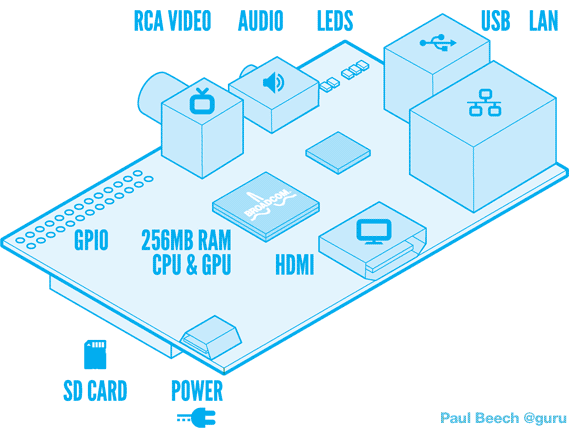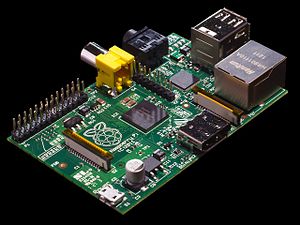Raspberry Pi on stage

I am extremely excited about Raspberry Pi, a low-power ARM-based Linux box on-a-board. This little board has a Broadcom ARM processor, HDMI port capable of digital audio and 1080p video playback (!), analog audio output, composite video output, a pair of USB ports (on one USB bus), an Ethernet port (!), a general purpose I/O bus, an SD card reader for system software, and it is all powered by a measly micro-USB port from the nearest cell phone charger (or batteries!).
Did I mention it’s only $35? I’ve already ordered mine, and it should arrive in a few weeks. In total, it cost $45 CAD to ship to my door with currency conversion, which is pretty awesome. For that price, I couldn’t even buy an Apple TV, or a Roku SoundBridge, or an AirPort Express all of which this device could easily sit in for. I have acquired many different media gadgets over the years, all of which are basically single-purpose, quickly go out of date, and would be super awesome if they could be hacked to do more things.
While I will probably pick up a few more (as soon as production starts to meet demand) for various media and automation tasks around the house, my main point of interest is how this device can be used on the stage. A computer this sized blows away what we could do a few years ago with Arduino, allowing us to put the power of a desktop computer inside pieces of set, on performers, and even in the hands of the audience.

It also becomes the most universal “problem solver” box ever. Plug in a USB MIDI adapter and you’ve got yourself an OSC to MIDI converter. Add on some physical sensors and its now an infrared MIDI controller. Add on an Entec DMX Device and you’re controlling your lighting rig on a board the size of your palm.
But what about video? The Linux and Open Source community have been busy writing beautiful video software like VLC for a long time, so who is to say these devices aren’t our next media servers? A quick word of caution, I’m mostly talking about “indie” theatre, or productions whos budgets typically fit within the cost of a single license to higher-end video playback systems such as Watch Out. However I think there’s tremendous potential in an array Raspberry Pis networked for live video playback at a fraction of the cost of current solutions.
I’ll be sure to post more when I get my personal Raspberry Pi. What would you use it for?

June 1, 2012 @ 10:02 pm
Dude, I need a pile of these.
They could be quickly configured for ally things automation!
The sure beat current I/O modules at nearly $4000 per axis.
If I knew much at all about programming, I’d be next in line for one.
Let me know how your projects work out!
Ayrton
June 1, 2012 @ 11:31 pm
Totally. Probably not as certified for automation purposes, but still awesome. Get one. You don’t need to be an expert programmer to get started!